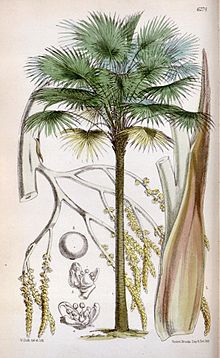Australian Livingston Palm
| Australian Livingston Palm | ||||||||||||
|---|---|---|---|---|---|---|---|---|---|---|---|---|

Australian Livingston Palm ( Livistona australis ) |
||||||||||||
| Systematics | ||||||||||||
|
||||||||||||
| Scientific name | ||||||||||||
| Livistona australis | ||||||||||||
| ( R.Br. ) Mart. |
The Australian Livingstonpalme ( Livistona australis ) is a plant from the genus of Livistona within the family of the palm family (Arecaceae). Their natural range is in Australia .
Description and ecology
The trunk of the Australian Livingston Palm reaches a height of up to 30 meters with a diameter of about 35 centimeters compared to other Livistona species. There is a crown of leaves on the trunk . The 3 to 4.5 meter long leaves are divided into a petiole and a leaf blade. The shape of the leaf blade is fanned out (palmat, fan palm ). The shiny leaf blade is about 1 meter wide. The spreader segments are bent downwards from about 2/3 of their length.
Many flowers stand together in inflorescences . The cream-white, hermaphrodite flowers are threefold. When ripe, the initially red fruits turn black. The Australian Livingston Palm blooms and bears fruit all year round.
Occurrence
The Australian Livingston Palm is widespread on the east coast of Australia in the states of Queensland , New South Wales and Victoria . It often thrives in swampy locations in open moist forests or on the edges of evergreen rainforests.
Taxonomy
It was first described in 1810 under the name ( Basionym ) Corypha australis by Robert Brown in Prodromus Florae Novae Hollandiae et Insulae van-Diemen , p. 267. The new combination to Livistona australis (R.Br.) Mart. was published in 1838 by Carl Friedrich Philipp von Martius in Historia Naturalis Palmarum , Volume 3, p. 241.
use
The Australian umbrella palm is used as an ornamental plant in rooms or tropical parks and gardens. The Aborigines of Australia use the leaves to make roofs for their huts, as they are very stable, and to weave baskets.
Individual evidence
- ^ A b Livistona australis in the Germplasm Resources Information Network (GRIN), USDA , ARS , National Genetic Resources Program. National Germplasm Resources Laboratory, Beltsville, Maryland. Retrieved April 17, 2014.
- ↑ a b c d e f g h Royal Botanic Gardens & Domain Trust, Sydney, NSW. ( Memento of the original from February 10, 2014 in the Internet Archive ) Info: The archive link was inserted automatically and has not yet been checked. Please check the original and archive link according to the instructions and then remove this notice.
- ↑ Martius scanned in at biodiversitylibrary.org in 1838 .
- ^ Livistona australis at Tropicos.org. Missouri Botanical Garden, St. Louis, accessed April 17, 2014.
